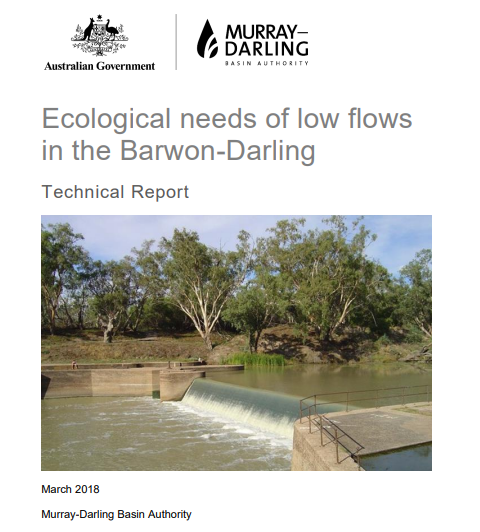New report shows water extraction a “significant factor” in increased low flows on Murray Darling Basin
- March 7, 2018
- Posted by: administrator
- Category: Environmental, Australasia

Reports released by the Murray Darling Basin Authority (MDBA) today show that, since 2000, there have been much longer periods of no-flow or low- flow events – and water extraction is a significant factor.
The report says irrigation extractions occur along the entire length of the Barwon River and in the upper sections of the Darling River and that there is “acute pressure from competing demands”.
MDBA’s head of Environmental Management, Carl Binning, said the reports were an important part of the work underway to implement a ‘toolkit’ of measures agreed by Queensland, New South Wales and the Commonwealth to protect environmental water and ecologically important small flows in the Northern Basin.
“The MDBA is today releasing two reports—a detailed analysis of ecological needs and an examination of hydrological history in the Barwon–Darling,” Binning said.
“We examined publicly availably gauge data for individual small-flow events from 1990 to 2017, and also analysed ecological needs for small in-channel flows. We found that regular small inchannel flows are of critical importance during dry times for both the environment and downstream communities.”
The flows are needed to maintain populations of native fish and other aquatic creatures and support their breeding activity, to maintain water quality and long-term connectivity through the Barwon–Darling river system and its tributaries. They also play a role in helping to manage water quality and meet requirements for supply of water for critical human needs.
Carl Binning continued:
“Therefore, it is important for the health of the river system and Basin communities to minimise the duration of very low and no-flow periods—however, we also found that since 2000 there have been much longer periods of no to very low flows.
“While there are natural drivers for this change, our analysis suggests water extraction is a significant factor.
“This is precisely the kind of impact which the Basin Plan exists to manage and regulate—and is yet another reason why implementation of the Plan is so important for the future of the Basin and its communities and industries.
“Maintaining flows is particularly challenging in river reaches with unregulated flows such as the Barwon–Darling—that is, where flows are predominately dependent on rainfall and it is not possible to release water from dams to supplement flows.
“In these unregulated systems, specially tailored rules are required in order to be able meet the ecological needs of the river system while balancing the needs of other water users.”
“That is why we made the Northern Basin Amendment contingent on a ‘toolkit’ of measures to protect environmental water and ecologically significant small flows in the Northern Basin—and reports into compliance by the MDBA and Ken Matthews also reinforced the need for such measures in its recommendations.
The Toolkit Measures were the outcome of extensive research and consultation of the Northern Basin Review. The aim of the work on the reports released today was to provide a strong evidence base to inform the development of these measures.
According to Carl Binning, putting measures in place to protect environmental flows is complex because of the need to ensure fair and equitable access to water resources for all other users. It was important to thoroughly analyse and understand the implications of any proposed policy change—the work being undertaken in cooperation with the New South Wales government.
The NSW has established a Taskforce which will report within 90 days on recommended immediate and long-term policy solutions for protecting environmental and small flows and the MDBA’s reports will inform the work of the Taskforce.
Most of the Murray-Darling system has recently been placed on red or amber alert for outbreaks of blue-green algae.
Click here to download Ecological needs of low flows in the Barwon-Darling
Click here to download Observed Flows in the Barwon–Darling 1990-2017: A Hydrologic Investigation
